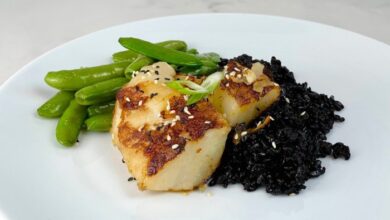
Japanese Pickled Watermelon Rind: A Sweet and Sour Delight
Japanese pickled watermelon rind, a unique and surprisingly delicious food, takes the humble watermelon rind and transforms it into a sweet and sour treat. This culinary tradition, steeped in history and cultural significance, showcases the ingenuity of Japanese cuisine in utilizing every part of a fruit.
While watermelon is enjoyed fresh throughout the world, Japan has embraced the rind, turning it into a flavorful and refreshing side dish, a surprising ingredient in desserts, and even a popular snack.
The process of pickling watermelon rind in Japan is a meticulous one, involving careful salting, fermenting, and seasoning with a blend of sugar, vinegar, and spices. This process results in a texture that is both crunchy and tender, with a flavor profile that is both sweet and tangy, offering a delightful contrast of taste and texture.
The origins of this practice are said to date back centuries, when resourceful cooks sought ways to preserve the abundance of watermelon during the harvest season. Today, Japanese pickled watermelon rind continues to be a beloved food, enjoyed by generations of Japanese families and gaining popularity beyond the borders of Japan.
Japanese Pickled Watermelon Rind
Japanese pickled watermelon rind, known as “Suika no Tsukemono” in Japanese, is a unique and refreshing delicacy that has been enjoyed in Japan for centuries. It’s a testament to the Japanese culinary tradition of utilizing every part of an ingredient, even those that might be considered waste in other cultures.
History and Cultural Significance
The origins of pickled watermelon rind in Japan can be traced back to the Edo period (1603-1868). During this time, watermelon was a luxury item, and people were eager to make use of every part of the fruit. Pickling the rind became a way to preserve the watermelon’s flavor and extend its enjoyment beyond the summer months.
Traditionally, pickled watermelon rind was a popular snack or side dish served during the summer months, often alongside chilled noodles or rice. It was also used as a filling for onigiri (rice balls) and as an ingredient in other dishes.
The bright pink color of the pickled rind also made it a visually appealing addition to meals.
Traditional Methods
The traditional method of pickling watermelon rind involves a multi-step process that utilizes natural ingredients and traditional techniques. The rind is first carefully peeled and cut into strips or cubes. It is then soaked in salt water for several days to draw out excess moisture and firm up the texture.
After the salting process, the rind is rinsed and drained. It is then simmered in a mixture of sugar, soy sauce, rice vinegar, and other seasonings, such as ginger, chili peppers, or yuzu. The mixture is often flavored with kombu (kelp) for added umami.
The rind is simmered until it is tender and has absorbed the flavors of the pickling liquid.
Anecdotes and Stories
One interesting anecdote about pickled watermelon rind is that it was once considered a “poor man’s food.” In the past, when watermelon was a luxury item, people would often eat the rind as a way to make the most of their purchase.
Another interesting story is that pickled watermelon rind was once used as a remedy for heatstroke. It was believed that the rind’s cooling properties and the vinegar’s acidity could help to alleviate the symptoms of heatstroke.
Nutritional Value and Health Benefits
Pickled watermelon rind, a unique and tangy delicacy, offers a surprising array of nutritional benefits. While often overlooked, this fermented treat packs a punch when it comes to vitamins, minerals, and antioxidants.
Nutritional Profile
Pickled watermelon rind is a good source of several essential nutrients, including:
- Vitamin C:This powerful antioxidant helps protect cells from damage and supports immune function. A 100-gram serving of pickled watermelon rind can provide around 10% of the daily recommended intake of vitamin C.
- Potassium:This electrolyte plays a crucial role in maintaining fluid balance, regulating blood pressure, and supporting muscle function. Pickled watermelon rind is a good source of potassium, contributing about 5% of the daily requirement per 100-gram serving.
- Fiber:Pickled watermelon rind is a decent source of dietary fiber, which promotes digestive health, helps regulate blood sugar levels, and contributes to feelings of fullness. A 100-gram serving can provide around 2 grams of fiber.
Health Benefits
The nutritional profile of pickled watermelon rind translates into a variety of potential health benefits.
Japanese pickled watermelon rind is a fascinating treat, offering a surprisingly savory and tangy flavor profile. It’s a great example of how cultures can transform seemingly simple ingredients into something truly unique. I recently found myself craving a similarly complex flavor combination and stumbled upon a recipe for maple whiskey bbq sauce , which reminded me of the depth of flavor found in the pickled rind.
Both showcase a delicate balance of sweet and savory, making them perfect additions to any meal.
- Improved Digestion:The high fiber content in pickled watermelon rind can help regulate bowel movements and prevent constipation. Fiber also promotes the growth of beneficial bacteria in the gut, which plays a vital role in overall digestive health.
- Hydration:Pickled watermelon rind, like its fresh counterpart, is a good source of water, which is essential for maintaining hydration and overall bodily function.
- Antioxidant Protection:The presence of vitamin C and other antioxidants in pickled watermelon rind helps protect cells from damage caused by free radicals, which are unstable molecules that can contribute to aging and disease.
Comparison with Other Fermented Foods
While pickled watermelon rind is a unique and lesser-known fermented food, its nutritional profile aligns with other popular fermented options.
- Sauerkraut:Similar to pickled watermelon rind, sauerkraut is a fermented cabbage dish rich in vitamin C, fiber, and probiotics.
- Kimchi:This Korean fermented cabbage dish is also a good source of vitamin C, fiber, and probiotics, and it is known for its unique spicy flavor.
- Kombucha:This fermented tea beverage is rich in probiotics and antioxidants, and it is often touted for its potential digestive and immune-boosting benefits.
Culinary Uses and Flavor Profile

Pickled watermelon rind, known as “Suika no Tsukemono” in Japanese, holds a special place in Japanese cuisine, offering a unique and refreshing twist to both traditional and modern dishes. Its flavor profile is a delightful blend of sweet, sour, and salty notes, making it a versatile ingredient that can be enjoyed in various ways.
Japanese pickled watermelon rind is a surprisingly refreshing and tangy treat. The sweet and sour flavors make it a perfect accompaniment to many dishes, especially those with a rich, savory flavor profile. For example, I love pairing it with pork rub rubbed and baked pork chops , as the acidity of the pickled rind cuts through the richness of the pork.
The combination is a delightful balance of textures and tastes, making it a truly unique culinary experience.
Flavor Profile
The flavor of pickled watermelon rind is a harmonious combination of sweet, sour, and salty notes. The rind’s natural sweetness is enhanced by the pickling process, which involves soaking it in a brine solution often containing sugar, vinegar, and salt.
The vinegar adds a tangy sourness, while the salt contributes a savory depth. The result is a refreshing and complex flavor that can be both invigorating and comforting.
Japanese pickled watermelon rind, or “suri-ka”, is a unique and surprisingly delicious treat. The sweet and tangy flavor is a welcome change from the usual summer fruits. While I’m on the topic of unexpected culinary delights, have you tried making a whole chicken slow cooker recipe ?
It’s so easy and the results are tender and flavorful. But back to the suri-ka, it’s a perfect accompaniment to a light summer meal, and its bright, refreshing taste is a great contrast to the richness of the chicken.
Culinary Uses
Pickled watermelon rind is a popular ingredient in Japanese cuisine, featuring in a variety of dishes, both traditional and modern.
Traditional Dishes
- Tsukemono (Pickles):Pickled watermelon rind is a staple in the world of Japanese pickles, often served alongside rice and other dishes. It adds a refreshing and tangy counterpoint to the meal.
- Sushi:Some sushi chefs incorporate pickled watermelon rind into their creations, using it as a topping or a garnish. Its sweet and sour notes complement the savory flavors of the sushi rice and fish.
- Osechi Ryori (New Year’s Dishes):Pickled watermelon rind is often included in osechi ryori, a traditional Japanese New Year’s feast. It symbolizes good fortune and prosperity.
Modern Adaptations
- Salads:Pickled watermelon rind can add a unique twist to salads, providing a sweet and sour element that complements the fresh greens and other ingredients.
- Sandwiches and Wraps:The refreshing crunch and tangy flavor of pickled watermelon rind make it a delightful addition to sandwiches and wraps, adding a burst of flavor to the fillings.
- Appetizers:Pickled watermelon rind can be served as a standalone appetizer, offering a refreshing and palate-cleansing experience. It can also be incorporated into more elaborate appetizers, such as skewers or small bites.
Recipe Variations and Preparation Techniques: Japanese Pickled Watermelon Rind

The art of making Japanese pickled watermelon rind lies in mastering the balance of sweet, sour, and salty flavors, achieved through different ingredients and techniques. Experimenting with variations in marinades, sweeteners, and spices can create unique flavor profiles that cater to individual preferences.
Preparing Watermelon Rind
Proper preparation is crucial for achieving a tender and flavorful pickled watermelon rind. It involves a multi-step process that ensures the rind is adequately softened and infused with the marinade.
- Cutting the Rind:The green outer rind of the watermelon is discarded, and the white inner rind is carefully cut into desired shapes. Thin slices or cubes are common, allowing for even marinating and faster pickling.
- Salting:Salting is essential for drawing out excess moisture from the rind, which helps prevent spoilage and promotes better absorption of the marinade. The rind is typically salted for several hours or overnight, then rinsed thoroughly to remove excess salt.
- Fermenting:Fermentation is a crucial step in some recipes, adding a tangy and complex flavor to the pickled rind. The rind is often submerged in a brine solution containing salt, sugar, and sometimes rice vinegar for a period of days or weeks, allowing beneficial bacteria to develop.
Basic Recipe for Pickled Watermelon Rind
This recipe provides a simple and straightforward method for making Japanese pickled watermelon rind, focusing on the essential ingredients and techniques.
Ingredients:
- 1 kg (2.2 lbs) watermelon rind, cut into 1-inch cubes
- 1 cup salt
- 1 cup sugar
- 1 cup rice vinegar
- 1/2 cup soy sauce
- 1/4 cup mirin (sweet rice wine)
- 1 tablespoon ginger, grated
- 1 tablespoon garlic, minced
Instructions:
- Prepare the rind:Cut the watermelon rind into 1-inch cubes. Place the rind in a large bowl and sprinkle generously with salt. Mix well and cover the bowl with plastic wrap. Refrigerate for 4-6 hours, or overnight, allowing the salt to draw out moisture from the rind.
- Rinse and drain:After salting, rinse the rind thoroughly under cold water to remove excess salt. Drain well in a colander.
- Prepare the marinade:In a saucepan, combine the sugar, rice vinegar, soy sauce, mirin, ginger, and garlic. Bring to a simmer over medium heat, stirring until the sugar dissolves. Remove from heat and let cool completely.
- Pickle the rind:Transfer the drained rind to a sterilized jar or container. Pour the cooled marinade over the rind, ensuring it is fully submerged. Cover tightly and refrigerate for at least 3 days, or up to 2 weeks, allowing the rind to pickle and absorb the flavors.
Variations and Flavor Profiles
The basic recipe can be adapted to create various flavor profiles by incorporating different ingredients and techniques.
- Spicy:Add chili peppers, such as serrano or habanero, to the marinade for a spicy kick. Adjust the amount based on desired heat level.
- Citrusy:Include lemon or lime zest in the marinade for a bright and refreshing citrus flavor.
- Herbal:Incorporate fresh herbs like mint, basil, or cilantro to add a fragrant and aromatic touch to the pickled rind.
- Sweet and Sour:Increase the sugar content in the marinade for a sweeter profile. Alternatively, use a combination of white sugar and brown sugar for a more complex sweetness.
Tips for Success
- Use fresh watermelon:The quality of the watermelon rind directly affects the flavor and texture of the pickled rind. Use fresh, ripe watermelon for the best results.
- Sterilize jars:Properly sterilize jars and lids before packing the pickled rind to prevent spoilage.
- Refrigerate:Store pickled watermelon rind in the refrigerator to maintain its freshness and flavor.
Cultural Significance and Modern Trends

Pickled watermelon rind, known as “Suika no Kakuni” in Japan, holds a significant place in Japanese culinary traditions and celebrations. It’s a testament to the country’s resourceful use of ingredients and a symbol of both tradition and adaptability.
Cultural Significance, Japanese pickled watermelon rind
Pickled watermelon rind is a beloved side dish in Japan, particularly during the summer months when watermelons are in season. Its origins can be traced back to the Edo period (1603-1868) when preserving food was essential for survival.
- Watermelon rind, often discarded, was repurposed into a tangy and refreshing pickle. This practice reflects the Japanese value of “mottainai,” meaning “waste not, want not.”
- Pickled watermelon rind is often served alongside grilled fish, rice, or noodles, adding a contrasting flavor and texture to the meal.
- It’s also a popular accompaniment to summer festivals and gatherings, offering a light and refreshing palate cleanser.
Growing Popularity Outside Japan
The popularity of pickled watermelon rind is gradually spreading beyond Japan’s borders, attracting the attention of food enthusiasts and chefs worldwide.
- The unique flavor profile, combining sweetness, tanginess, and a hint of bitterness, is gaining recognition for its versatility and complexity.
- The rise of global cuisine and the increasing interest in traditional Japanese food have contributed to its growing appeal.
- Pickled watermelon rind is also attracting attention for its health benefits, as it’s low in calories and a good source of vitamins and minerals.
Modern Innovations and Adaptations
Pickled watermelon rind is no longer confined to traditional Japanese cuisine. Chefs and food innovators are experimenting with its use in diverse dishes, pushing the boundaries of culinary creativity.
- Cocktails:The tangy and refreshing flavor of pickled watermelon rind is being incorporated into cocktails, adding a unique twist to classic drinks. For instance, a “Suika Margarita” combines tequila, lime juice, and pickled watermelon rind, creating a refreshing and complex cocktail.
- Desserts:The sweet and sour profile of pickled watermelon rind lends itself well to desserts. Chefs are incorporating it into ice cream, sorbet, and even cakes, creating innovative and surprising flavor combinations. A “Suika Cheesecake” might incorporate pickled watermelon rind into the cheesecake filling, adding a unique tanginess to the creamy base.
- Other Creative Dishes:The versatility of pickled watermelon rind allows it to be incorporated into various dishes, from salads and sandwiches to pizzas and stir-fries. It can add a burst of flavor and texture to any dish, making it a truly adaptable ingredient.





